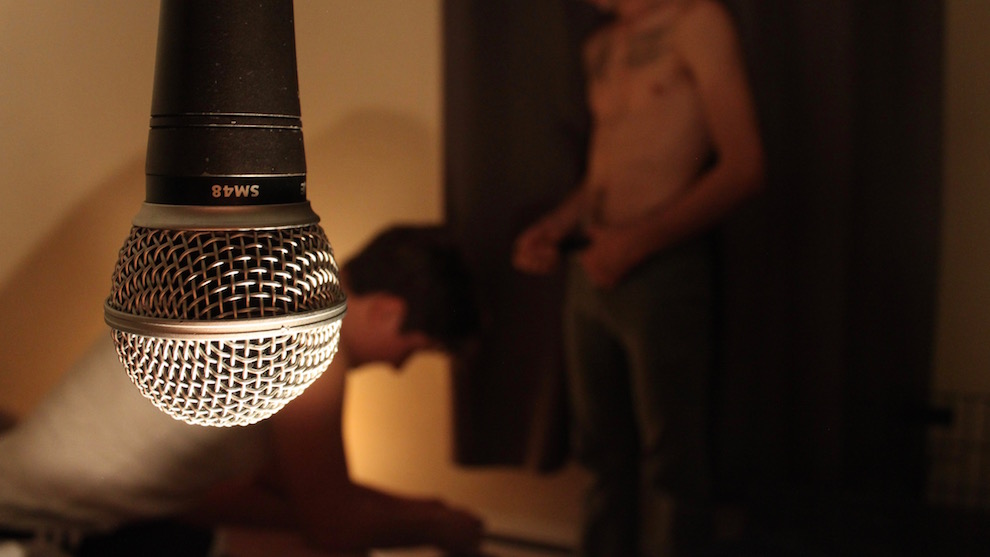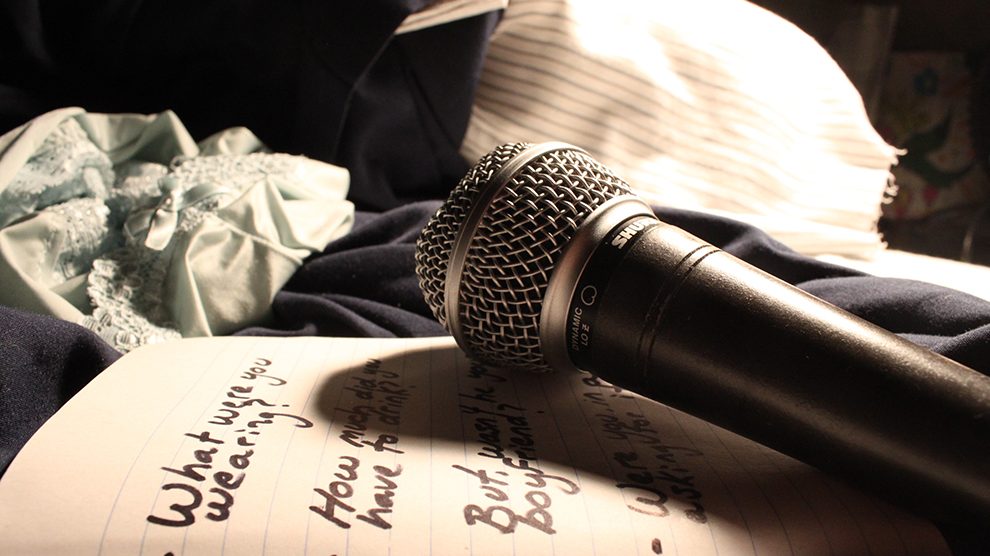Reporting
It’s a crime

caption
How should journalists cover rape?
Shannon Graham anxiously paces around her living room in Bridgewater, Nova Scotia. She is about to do something she has never done in her life: appear on television. She plays with blocks alongside her infant son to calm her growing nerves. It’s an ordinary spring day; the sun peeks through the clouds while a crisp breeze blows through trees still naked from the winter.
When the news team knocks on her door Shannon is surprised to find only one reporter and one cameraman, not the full television crew she envisioned. As the pair begin to set up Shannon’s nervousness skyrockets. She fears that her story will be misunderstood. She fears judgment by her friends. Shannon takes a deep breath; she is ready to speak on camera about being raped.
Statistics Canada estimates that every year one in six Canadian women are sexually assaulted. Sexual assault is an umbrella term to describe attacks of a sexual nature. This means rape is sexual assault, but not all sexual assault is rape (more on this later). Nearly 80 per cent of sexual assault victims know their attacker, like Shannon, who was attacked by her now ex-boyfriend.
Of every 100 cases of sexual assault in Canada, Statscan says, a mere six are reported to the authorities. Graham is one of the rare women who reported her case to the police. After taking the first steps to pursue legal action against her ex, Shannon faced a new torment: enduring the archaic stigmas of sexual assault.
“I’ve talked to people who said ‘well, he was your boyfriend, so what?’,” said Graham. “The fact that I said no and tried to shove him off of me is enough. It doesn’t matter that I’m in a relationship or not.”
Acquaintance rape—when the victim knows the attacker personally— is rarely presented in news media, while cases where the attacker is a stranger circulate like wildfire. Acquaintance rape survivors fight to have their cases taken seriously by their peers, community and family. This creates an environment where survivors feel that their cases are not worthy of reporting to the police.
“I waited three days to go to the police,” Graham said, “because I just thought: ‘well, is this wrong’.”
LISTEN: Shannon Graham remembers the phone call that told her that her ex-boyfriend, who had been convicted of sexual assault, was appealing his sentence and was already released from jail after serving only two months of his two-year sentence.
Rape Culture in the Media
Cases where a stranger attacks a victim who is either drunk and/or alone is often what we think of when we hear the word “rape”. This is a common misconception or, as many feminist scholars say, “rape myth”. Complete strangers commit only 10 per cent of sexual assaults.
Surprised? Most of our ideas of what constitutes “real” rape are incredibly inaccurate. There are many myths about rape: the victim “was asking for it”, men cannot control their sex drives, and the victim fabricated the assault are only a few.
Misconceptions about rape are especially prevalent in cases that involve celebrities. These also happen to be the rape stories that receive the greatest media coverage and are shared the most through social media. During the coverage of the Kobe Bryant sexual assault case in 2003, studies found that more than 65% of news articles included rape myths.
A 2008 study by researchers at Aurora University, near Chicago, published in the peer-reviewed monthly journal Violence Against Women, examined the effects of rape myths in the news. The study concluded that readers strongly believe these myths, and are less likely to believe the victims’ statements. Dr. Renae Franiuk, a professor of psychology who led the study, says the overwhelming prevalence of rape myths in the news skews the readers’ perceptions of sexual assault.
“We focus on the wrong types of cases, which makes it harder for women to report because it makes them feel that their cases are an anomaly,” said Franiuk. “They feel like they’re the strange ones when their date or their boyfriend rapes them and they’re not seeing that in the news.”
Rape myths are a product of rape culture. Rape culture—a term coined in the by second-wave feminists in the U.S. in the 1970s—describes the mindset toward sexual assault that scrutinizes the victim’s actions without critically analyzing the attacker’s actions. This set of beliefs, which normalizes sexual violence, is perpetuated though many parts of our culture, especially news media.
Franiuk said psychology explains why we accept these myths so often. We do not want to believe that someone close to us could be capable of this crime, so it is easier to accept the myth than confront reality. This is why cases of stranger rape circulate disproportionately often, and why our ideas of rape are so misinformed.
Franiuk’s research supports the idea that journalists who report on sexual assault need to take great care. News media has the power to help ensure that survivors of sexual assault can feel safe to come forward with their stories.
The role of a journalist
Kayla Hounsell, the CTV journalist who arrived to cover Graham’s story, feels the way to debunk rape myths is to report more often on these more frequent cases of sexual assault. “Reporters don’t cover (sexual assault) enough because we’re scared of it,” Hounsell says. “It’s so easy to do it wrong that we just won’t do it at all. And I think that’s really not the right answer.”
In 2013 Hounsell took an intensive week-long course, called Power Reporting, at the Poynter Institute in Florida. The course teaches journalists how to cover sexual assault ethically, so their stories minimize emotional harm for the victims and showcases reality.
“We should be covering more (acquaintance rape),” said Hounsell. “That is the reality, and if the statistics show that, then to do anything otherwise would be fear-mongering.”
There are always two sides (or more) to any story. Kathy English, the public editor of the Toronto Star, says good reporting demonstrates balance and fairness to both sides of a disagreement, and does not add to the victim’s distress or play in to stereotypes. “The imperative as a reporter,” said English, “is that my writing does not further victimize the victims of sexual assault.”

caption
Rape is a sensitive subject, and reporting it well requires knowledge and care.Reporters covering sexual assault walk a fine line of balance. Bob Steele, a journalism professor and ethics scholar, formerly at Poynter and now at DePauw University in Indiana, formulated a principle of good reporting that it might be helpful to remember: minimize harm.
Words matter
Thirty-three years ago the language that reporters use to report sexual assault completely changed. In 1983 the Canadian Criminal Code implemented Bill C-127, which replaced “rape” with three categories of sexual assault. This change means that no one in Canada is now charged with “rape”; instead, they are charged with one of three degrees of sexual assault. This is why readers today do not see “rape” in the news. The change was to make the crime less about sex, and more about what it truly is: an act of violence.
This leaves journalists who cover rape in a Catch-22. How do they report on the crime if the charge doesn’t exist in the Criminal Code? Some journalists have struggled to work within the confines of the legal language. But now more resources are available for those who cover sexual assault.
In 2015 a feminist organization in Toronto, Femifesto, collaborated with dozens of professors, health professionals and news outlets to create Use the Right Words, a media guide for journalists. This media toolkit stresses the importance of fair and exact language, and offers guidance on word choices for journalists reporting on sexual assault.
“Don’t overuse words like ‘alleged’ or ‘accused’,” the guide advises. “Excessive use of these words can imply disbelief of the survivor on the part of the reporter.”
Shannon Giannitsopoulou, one of the co-founders of Femifesto, says the group has been doing a lot of work on social media with the #UsetheRightWords campaign. The hashtag urges media to cover assault by using words that are precise and fair.
“No language is neutral,” said Giannitsopoulou in an email. “Words and linguistic choices used by friends, family, the criminal justice system, community leaders and media can haunt a survivor long afterwards.”
It has now been two years since Shannon Graham reported her assault to the police. Despite her initial nervousness, she was pleased with the way her case was handled by the media. After sharing her story with the world, Graham received many letters and emails thanking her for doing so. People from all over Canada reached out and explained how they too were victims of sexual assault, and applauded her for her bravery.
Graham wishes she would see more cases like hers reported in the news. And she knows that by sharing her story our society is one step closer to ending the stigma around rape.

